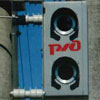
Safety On The Railway
Fiber-optic surveillance network provides safety, security on Russian lines
How does one of the largest railway companies in the world
protect its passengers from terrorist attacks and sabotage? The
Russian Railways deployed an ambitious surveillance project
to safeguard the nearly 1 billion passengers who ride the rail
system each year. The goal was to deploy surveillance cameras
that can spot terrorists along 53,000 miles of track 24 hours
a day and through the snow of the infamous Russian winters.
The Russian Railways employs 950,000 people and is a monopoly
of the Russian Federation headquartered in Moscow. The company
operates commuter rail and regional rail services throughout
the country, using mostly electric trains known as “elektrichka.”
The Russian Railways operates the second-largest rail network in
the world exceeded only by the United States. More than 4,000
commuter trains a day are running on the rail network, with more
than a thousand in the Moscow metropolitan area.
The railway is using a variety of systems integrators and installers
that work under the umbrella of the government-owned
national rail carrier to deploy anti-terrorist surveillance systems,
which are being deployed in different regions using integrators
throughout the country.
There were three key challenges in this project.
The first was to install cameras at remote locations along the
many miles of track. The second was to provide surveillance images
day and night, and through snow and rain. The third was to
deploy equipment that could withstand extremely cold weather.
The distance challenge was complicated by the fact that many
of the cameras deployed used Power over Ethernet. PoE is a useful
technology in powering remote cameras, but as with any copper
network cable, the challenge lies in the limited distance and
bandwidth of copper unshielded twisted-pair cabling. The maximum
length for a standard copper UTP Ethernet cable segment is
100 meters (328 feet), and PoE power sourcing equipment—like
midspan power injectors—does not increase the distance of the
data network.
There are several solutions available to extend the distances of
PoE network links, including fiber-optic cabling, LAN extenders
that convert Ethernet to DSL over UTP copper cable, UTP to
coax converters and wireless. Fiber was chosen because it provides
several distinct advantages over these technologies and can
extend network distances up to 87 miles. LAN extenders reach up
to 3,000 feet, and UTP to coax converters up to 1,200 feet. Fiber
is the most reliable because it is not susceptible to electrical interference—
an issue with electric commuter trains—temperature or
atmospheric conditions like snow and rain. Fiber supports the
highest data rates—1 gigabit or more with multiplexing—and has
intrinsic security advantages because it is difficult to tap and has
no electromagnetic emission.
But fiber cannot transmit the electrical current required for
PoE and PoE+ powered cameras. Omnitron’s OmniConverter PoE
media converters were selected to convert fiber cabling to copper
UTP and inject PoE on the RJ-45 port. The OmniConverter PoE
media converters can provide power to one or two cameras using
standard UTP cables that carry the Ethernet data and function like
a PoE mini-switch. Several OmniConverter port configurations are
available, including one or two RJ-45 and fiber ports.
OmniConverters also are available in two power levels. They can
provide up to 15.4 watts of power per UTP port for IEEE 802.3af
PoE or up to 25.5 watts per port for IEEE 802.3at PoE+ for powerhungry
cameras with PTZ and built-in heaters and blowers.
A typical Russian Railways surveillance system incorporates fiber cabling deployed in a star topology, where several fiber cable
runs are distributed from a switch with fiber-optic ports. The
switches are connected via gigabit fiber links to an aggregation
switch at a regional command center. The fiber that connects the
cameras terminates at a custom-built enclosure that houses two
cameras and an OmniConverter. Each camera is powered from an
RJ-45 port on the media converter, and OmniConverter is powered
by a local AC power source. This was the configuration used
along the Oktaybr’syaya Railway from St. Petersburg to Moscow.
The challenge of providing surveillance images day and night
and when weather limits visibility was overcome by installing a
video camera and a thermal imaging camera in each enclosure.
Video cameras provide surveillance in daylight, and the thermal
cameras provide surveillance at night and in snow and rain. A
variety of camera brands and models were used in the project, including
several from Russian manufactures. All cameras were IPbased
and transmitted video signals over the Ethernet network.
A multi-port PoE media converter was installed in the enclosure
to convert the fiber to two copper UTP cables that provide data
connectivity and PoE to both of the cameras.
The extreme cold challenge was overcome by using temperature-
hardened cameras and PoE media converters. The cameras
and the PoE media converters selected for the project are hardened
to operate within a -40 degrees C to +75 degrees C (-40
degrees F to 167 degrees F) temperature range.
In deployments inside terminals and stations, a single video
camera is all that was needed. Distances still required running
fiber to the camera, so a PoE media converter with one PoE RJ-
45 port is used. In other deployments, cameras that are directly
AC powered are deployed with fiber connectivity. These cameras
didn’t require PoE, but required copper-to-fiber conversion because
they did not have integrated fiber ports. In these applications,
Omnitron’s miniature miConverter media converters—
about half the size of a deck of cards—were used to provide
copper to fiber connectivity in a compact enclosure.
For all the Russian Railways deployments,
using an Ethernet network with fiber cabling,
IP cameras and media converters provided flexible
solutions for surveillance at long distances
in a variety of weather conditions.
This article originally appeared in the June 2012 issue of Security Today.